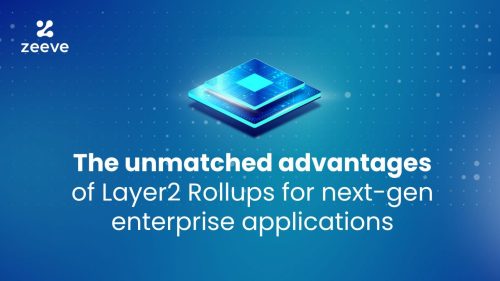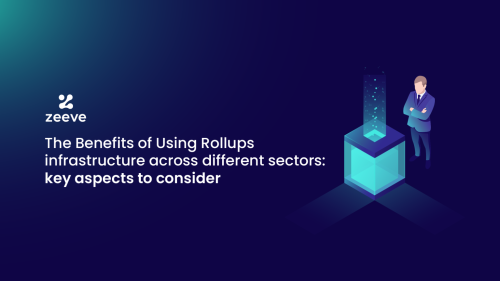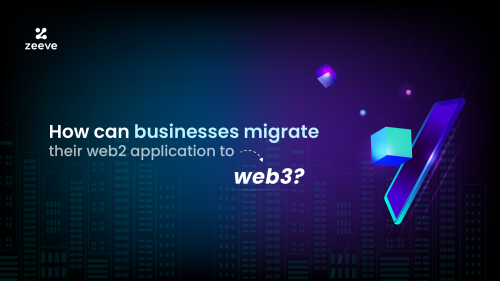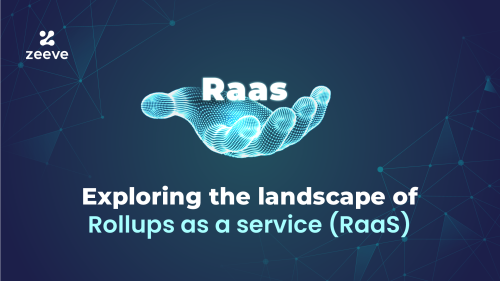
Layer2 Rollups: Powering Next-gen enterprise applications
Layer2 rollups have been a game-changer for the web3 landscape, whether it’s about enhancing the capabilities of Layer1 blockchains, upgrading dApps for superior performance, or powering enterprise applications with next-gen capabilities. While dApps and layer1 blockchains are forerunners in terms of rollups’ adoption, enterprise applications have recently started to shift to the Layer2 rollups ecosystem.
Hence, let’s highlight the advantages of rollups for enterprise applications in this article. Also, we will talk about the common challenges that enterprises face while launching or managing their applications on public L1/L2 blockchains. Lastly, there will be a brief discussion about the enterprises using rollups-based ecosystems for their applications. Let’s start off!
What challenges enterprise applications face on Layer1/layer2 public blockchain?
Challenge1: Meeting the growing scalability demands:
Enterprise applications, especially those with a large customer base and multiple partners, often demand high TPS and quick response time. But, they will face scalability issues on a public blockchain like Ethereum. That’s because public blockchains are highly congested due to a large number of web3 applications being managed on it. Scalability solutions like sharding or creation of permissioned blockchain can solve this scalability problems, but these will pose additional challenges such as complexity of infrastructure management, security issues, and technical challenges. At this point, Layer2 rollups serves as an ideal solution to tackle scalability issues of enterprise applications.
Challenge2: Adding privacy and network-level permissions:
Public blockchain ecosystems are designed to be open-sourced where anyone can join as a network participant by running their own node. Participants’ purpose can be different, be it building dApp or validating the network. Whereas, enterprise applications are designed to operate within a corporate environment with special privacy and network-level permissions, for example– who can be a user, who all can access the data, who can audit the transactions, etc. Thus, building your enterprise application on a public blockchain will not allow you to privatize your application and its operations.
Challenge3: Challenges of customizability and sovereignty:
Enterprise applications like consumer-level apps may want customization at their execution layer. Problem is that Layer1/Layer2 solutions lack customization, it cannot allow your application to be customized to fulfill the specific needs of your organization and its members. Likewise, sovereignty is a problem in L1/L2 blockchain, your application will be accessible and controlled by several entities and a number of network participants. Good thing is that blockchain rollups are optimized to address both of these issues for enterprise applications.
Challenge4: Network governance:
Enterprise application demands a sort of centralized governance, where only the organization-wide stakeholders can participate in discussion, submit proposals, or vote for crucial decisions. However, Layer1/Layer2 decentralized networks include public proposals, discussion, and votes from on-chain stakeholders. This makes network seamless governance a challenge for most of the enterprise applications.
Diving into the unmatched advantages of Rollups for next-gen enterprise applications
There are many advantages of rollups for enterprise applications. However, for this article, let’s focus on the main benefits that have been encouraging enterprises to launch rollup-based applications:
Dedicated scalability for higher throughput:
Rollups process transactions off-chain on a dedicated Layer2 with a simple on-chain verification method.This scaling technique allows enterprise applications to boost their scalability for massive throughput and instant response time. As we know, Layer1 Ethereum can currently offer 27-30 TPS. Whereas, Optimistic rollups can offer upto 2,000 transactions per second, and for ZK rollup, it can reach upto 10,000 TPS depending on the use case.
Access control and ownership benefits:
Enterprise applications, when deployed on their own independent Layer2 rollup chain, get the freedom to implement access control and permissions parameters, allowing only authorized participants to join the network or access it. Access can be granted through cryptographic keys, digital signatures, and unique authentication methods, whichever is feasible.
Enhanced data privacy & confidentiality:
Rollup ecosystems allow enterprise applications to enhance their privacy and add high level of security, ensuring that all the sensitive data and information are protected through confidentiality. Meaning that, you will have full control over who can access the data, check transactions, and other application-level information.
Lower transaction cost:
Transactions in Layer2 rollups are computed off-chain on a secondary framework, only some specific transaction data are stored on-chain. This approach reduces the transaction cost in enterprise applications significantly because the off-chain ecosystem does not see issues like high traffic and network congestion. Looking at YCharts data, the average costs of sending a token to Ethereum is $1-10, depending on the congestion. Whereas, the transaction fee is less than $1 on ZK-rollup networks. What’s more? Enterprise can use rollups to offer gasless/zero-gas transactions for their users, if they want.
Ease of customization:
Rollups offer a highly modular and flexible infrastructure, enable enterprises to configure their application based on the use case-specific requirements. Let’s say that if you are building an application for your supply chain company, then rollups will allow you to adjust its TPS capability, add specific features such as account abstraction (AA), maximize the response time, and a lot more.
Seamless interoperability:
Some enterprises applications can be complex, involving several stakeholders. For example, a logistic company will include manufacturers, suppliers, distributors, and retailers. Seamless interoperability among all these participants is important to maintain 100% coordination and information exchange. Rollups’ compatibility with Ethereum and seamless interoperability with all the other rollup chains allow the enterprises to ensure smooth cross-chain communication and information flow.

What type of enterprise applications should use Layer2 rollups?
- Financial institutions and Banks- Rollups allow all types of financial institutions to facilitate faster and cost-efficient payments & settlements, including cross-border payment transactions. With a dedicated rollup chain, such institutions can add required accessibility permissions to ensure privacy and confidentiality while streamline their trade and finance processes.
- Supplychain companies- Food, pharmaceutical, and luxury goods enterprises can use layer2 rollups to build next-gen supply chain applications. It will effectively track their logistics and journey of the shipments, while maintaining complete confidentiality and data privacy.
- Healthcare enterprises- Rollups allow healthcare enterprise to build applications that securely and efficiently manage all kinds of patient and healthcare records, and meanwhile ensure that data remain confidential and protected. Moreover, the pharmaceutical industry can leverage rollups-based applications to trace the production and distribution of medications, eliminating the risk of drug counterfeiting.
- Enterprises using web2 stack- Blockchain Rollups are not just beneficial for enterprises that are struggling to managing their application on L1/L2 public blockchains. Infact, enterprises that are currently using web2 stack can easily tap into rollup-based ecosystem and leverage next-level benefits for their applications, such as shifting data ownership to the users, eliminating the role of intermediaries, protecting their application against hacks and identity thefts, highly secure transactions, better onboarding and user experience, reduced upfront and application management cost, and a lot more.
Want to learn more about web2 application’s migration to web3?Read our comprehensive guide below: How can businesses migrate their web2 application to web3?
Who all are building their enterprise applications on Layer2 rollups?
Although said to be the ultimate solution to blockchain’s scalability problem, blockchain rollups are relatively new technology, which has started getting traction for some time. Below are some of the institutions that are leveraging the advantages of rollups for enterprises.
Libre Capital is now creating a dedicated L2– Libre chain using Polygon CDK. The chain will be entirely focused in issuance and distribution of tokenized assets, and meanwhile it will leveraging the battle-tested security of Ethereum. Plus, Libre will offer unlock next-level distribution abilities for asset managers and wealth advisors, for example– zero fees and paralleled access to a matured pool of investors.
Visa is using Ethereum Layer2 StarkNet for launching unique, self-custodial wallets integrated with ‘account abstraction’ feature. Visa explains that building their application on L2 rollups is an ideal choice because they can write precise rules for account holders, for example– the rules of approving pre-authorized payments. However, the same is complex on a public blockchain ecosystem. Visa’s solution aims at automating recurring payments, hence eliminating the need for user’s participation.
Mastercard is now launching a spotlight program– ‘Mastercard Artist Accelerator’ on Polygon. The program will focus on preparing five main artists, including music composers, DJ, and musicians by providing them all the tools, skills, and technologies they require to create their place in the digital economy.
LifeWallet (formerly known as MSP recovery) has launched LifeChain, an advanced healthcare system with Polygon Networks, which solves healthcare sector’s critical problems such as fraud, inefficiency in payments and outdated processes. Polygon’s power ecosystem allow LifeWallet to tokenize their medical claims, provide interconnectivity across providers, enable higher transparency into patient’s data, and most importantly, enhance the scalability of the platform.
The Central Bank of Italy is building a decentralized finance (DeFi) project on Polygon, aiming to help financial institutions benefit from DeFi and tokenized assets. This initiative comes from global banks working on central bank digital currencies (CBDCs) and seeking way to incorporate blockchain technology into their crucial operations such as payments. The Central Bank of Italy believes that their DeFi platform will make the transactions process faster, lower down the costs, and will create a more efficient infrastructure.
Launch your enterprise application on Layer2 rollups with Zeeve
Zeeve enables enterprise to seamlessly migrate from a public blockchain or Layer-1 ecosystem to L2 rollup at significantly lower cost and with 90% faster time-to-market. Also, enterprises can work with Zeeve launch their own custom L2 and L3 rollups for higher throughput, unlimited customizability, and interoperability of their application. To facilitate this, Zeeve offers a team of specialized web3 developers and blockchain experts that makes rollup launch/migration a simple task for enterprises.
Zeeve offers modular RaaS that enables enterprises and web3 projects to build custom rollup chains from scratch. Zeeve’s RaaS stack includes one-click deployment Sandbox along with a range of rollup integration options such as DA layer from Avail, Eigen Layer, and Celestia, Biconomy and Halliday for Account Abstraction (AA), Chainlink for decentralized oracles, Espresso and Radius for Decentralized Sequencer, Subgraph for data indexers, and LayerZero and Router Protocol for interoperability layer. For more information on how Zeeve is simplifying L2/L3 rollup launch, feel free to connect with our experts. You can schedule one-to-one call or drop your queries via email on this page.







Responses